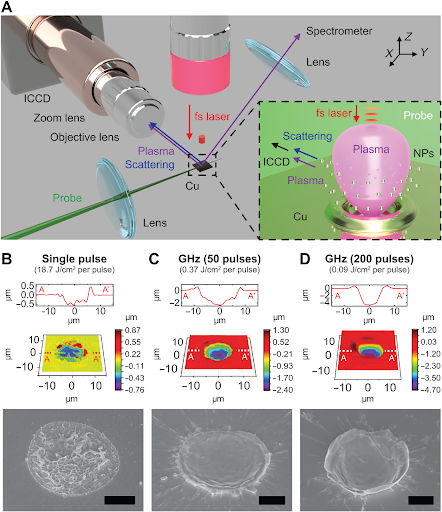A Rare Snapshot into Ultrafast Laser Ablation

A team of scientists from the Department of Energy’s Lawrence Berkeley National Laboratory (Berkeley Lab) have now made significant headway in describing the complex dynamics in the ablation of copper. Their novel imaging setups, described in Science Advances, allowed the real-time visualization of plasma plumes, copper particles, and ejecta streaks created by the laser on the metal’s surface across different time scales.
“GHz fs laser has shown new possibilities to engineer the physicochemical properties of materials. Our combined in-situ probing techniques as well as ex-situ characterizations allowed us to elucidate how GHz fs laser interacts with the materials in the nanosecond time domain,” said Minok Park, a project scientist at Berkeley Lab and co-author of the study.
Laser ablation – the process of removing material with a high power laser – has been an important technique to a wide range of applications from storing solar energy, surgically removing tumors, printing technologies, to material characterizations over the decades.
One type in particular, Gigahertz femtosecond laser ablation, intrigues researchers because aside from being extremely precise, it is so incredibly fast that there appears to be little heat conducted at the target material’s surface.
The exact mechanisms of interactions between ultrafast femtosecond laser bursts or single pulses and a targeted surface have remained obscured by the complexity of laser ablation dynamics.
One of the group’s key findings was that Gigahertz femtosecond bursts exert a recoil pressure onto the liquid pool, resulting in fast removal of a shallow pool of molten copper from the surface. With the molten material ejected and heat conduction minimal or absent, ablation essentially halts instantaneously.
By contrast, a single pulse led to a deeper pool of molten metal, lagging material removal and irregularly shaped, resolidified structures within the crater.
These new insights provide a foundation on which researchers can continue to build next-generation applications of ultrafast laser ablation.